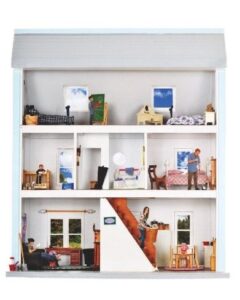As parents, we often hunt for lost socks and our keys at the last minute. We find legos and cheerios under the couch each time we vacuum the carpet. Keeping a perfectly organized house can be a challenge with small children, but you can easily have a “sort of” organized home. Use the following simple ideas to reduce the number of times you have to search for missing game pieces and pick up stray shoes.
Create a place for stuff.
Walk through your house and find a home base for items that you commonly find strewn about. Decide on a place for your children to put their backpacks when they return from school each day. If you are constantly searching for shoes, get a small shoe organizer to put near the door. Install hooks at your children’s height so they can hang up their jackets.
Be sure to find a spot for your purse, keys and cell phone. Joetta Tucker, professional organizer, suggests creating an “Inbox” for mail and school papers that you need to go through. Have your children pick up their papers from the “Outbox” after you sign them.
Sarah Shaw, mother of toddler twins, frustrated with bath toys overtaking her bathroom, hung a mesh bag on the wall over the tub. “The water drips out of the bag and the toys dry out. There is no mess and everyone is happy,” Shaw said. You can often find these bags in stores near the bath toys or you can use any mesh bag and add a suction cup to the top.
Use labels, bins and bags.
For organizing children’s toys, use bins and label the type of toy that goes into each bin. For younger children, put pictures on the bins so they can easily identify items in the appropriate container. You can either use open top bins displayed on a shelf or containers with lids. Put small toys and game pieces in sealable sandwich bags to keep the pieces together and label the bag with a permanent marker.
Families with multiple children of the same-sex often find clothes getting mixed up. Tucker suggests putting one small dot using a permanent marker on the tag of the oldest child’s clothes. “When the child outgrows it, add a dot to the tag and hand the item down to your second child,” Tucker said.
Pick small projects.
Your house did not get cluttered in a day and will not get uncluttered in a day or even a week. Choose a small project that will give you satisfaction to start with, such as a junk drawer that drives you crazy each day. After you have finished this project, enjoy your success for a few days and then find another small, but high impact project.
“You can’t organize clutter; you can only get rid of it. Don’t hold on to stuff for the next child. These things get in the way of your child having a place to play,” said Marla Cilley, the “Flylady” who shares her organizational strategies on her website www.flylady.net
Get your children involved.
Show your children where to put their items and gently remind them to place them in the correct spot each time you find them out of place. By enlisting your children in your battle against clutter, you are reducing your work, teaching them good organizational habits and helping them learn responsibility.
“When your child sees you making your bed, she is going to try to make her bed, too,” Cilley said. “Don’t allow your perfectionism to get in the way of her following you. Don’t go back and redo how she made her bed/her work. Teach her how but don’t whine that she is not doing it right.” She also suggests playing upbeat music while you and your children clean up together to help everyone get their cleaning “groove” on, and avoid the association of chores with dreariness.
Pick your organizational battles.
When your children grow up and move out, it will be a lot easier to have a perfectly organized house. While your children are young, have realistic expectations about the state of your home. “Housework done incorrectly still blesses your family,” Cilley said. “Our perfectionism areas of your house that you want organized and focus on keeping that aspect of your life in shape causes us to procrastinate.” Anytime you hear yourself say, “I don’t have time!” Just set your timer and do 15 minutes—even two minutes is better than nothing.
Choose the few areas of your house to focus your organizational efforts on. For example, if having a tidy laundry room makes you more productive, then spend a few minutes every day straightening it up.
Every few months, take stock of the organizational systems that you have set in place and see what is working for your family. Make any changes to your basket systems or start a new routine that you think will help you achieve your goal of a “sort of” organized home.





